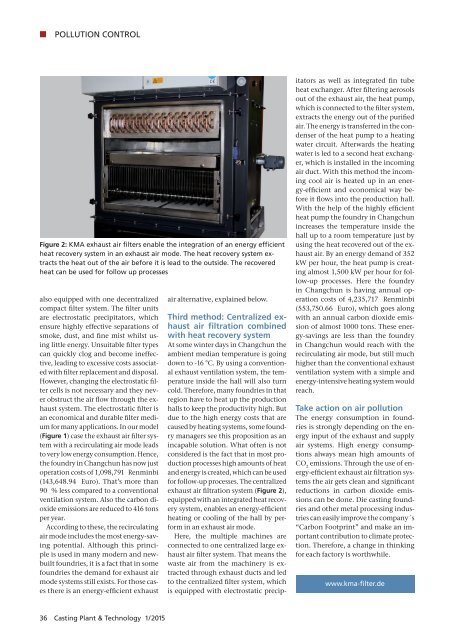CPT International 01/2015
The leading technical journal for the global foundry industry – Das führende Fachmagazin für die weltweite Gießerei-Industrie
The leading technical journal for the
global foundry industry – Das führende Fachmagazin für die
weltweite Gießerei-Industrie
Create successful ePaper yourself
Turn your PDF publications into a flip-book with our unique Google optimized e-Paper software.
POLLUTION CONTROL<br />
Figure 2:<br />
-<br />
<br />
<br />
also equipped with one decentralized<br />
compact filter system. The filter units<br />
are electrostatic precipitators, which<br />
ensure highly effective separations of<br />
smoke, dust, and fine mist whilst using<br />
little energy. Unsuitable filter types<br />
can quickly clog and become ineffective,<br />
leading to excessive costs associated<br />
with filter replacement and disposal.<br />
However, changing the electrostatic filter<br />
cells is not necessary and they never<br />
obstruct the air flow through the exhaust<br />
system. The electrostatic filter is<br />
an economical and durable filter medium<br />
for many applications. In our model<br />
( Figure 1) case the exhaust air filter system<br />
with a recirculating air mode leads<br />
to very low energy consumption. Hence,<br />
the foundry in Changchun has now just<br />
operation costs of 1,098,791 Renminbi<br />
(143,648.94 Euro). That’s more than<br />
90 % less compared to a conventional<br />
ventilation system. Also the carbon dioxide<br />
emissions are reduced to 416 tons<br />
per year.<br />
According to these, the recirculating<br />
air mode includes the most energy-saving<br />
potential. Although this principle<br />
is used in many modern and newbuilt<br />
foundries, it is a fact that in some<br />
foundries the demand for exhaust air<br />
mode systems still exists. For those cases<br />
there is an energy-efficient exhaust<br />
air alternative, explained below.<br />
Third method: Centralized ex-<br />
<br />
with heat recovery system<br />
At some winter days in Changchun the<br />
ambient median temperature is going<br />
down to -16 °C. By using a conventional<br />
exhaust ventilation system, the temperature<br />
inside the hall will also turn<br />
cold. Therefore, many foundries in that<br />
region have to heat up the production<br />
halls to keep the productivity high. But<br />
due to the high energy costs that are<br />
caused by heating systems, some foundry<br />
managers see this proposition as an<br />
incapable solution. What often is not<br />
considered is the fact that in most production<br />
processes high amounts of heat<br />
and energy is created, which can be used<br />
for follow-up processes. The centralized<br />
exhaust air filtration system (Figure 2),<br />
equipped with an integrated heat recovery<br />
system, enables an energy-efficient<br />
heating or cooling of the hall by perform<br />
in an exhaust air mode.<br />
Here, the multiple machines are<br />
connected to one centralized large exhaust<br />
air filter system. That means the<br />
waste air from the machinery is extracted<br />
through exhaust ducts and led<br />
to the centralized filter system, which<br />
is equipped with electrostatic precipitators<br />
as well as integrated fin tube<br />
heat exchanger. After filtering aerosols<br />
out of the exhaust air, the heat pump,<br />
which is connected to the filter system,<br />
extracts the energy out of the purified<br />
air. The energy is transferred in the condenser<br />
of the heat pump to a heating<br />
water circuit. Afterwards the heating<br />
water is led to a second heat exchanger,<br />
which is installed in the incoming<br />
air duct. With this method the incoming<br />
cool air is heated up in an energy-efficient<br />
and economical way before<br />
it flows into the production hall.<br />
With the help of the highly efficient<br />
heat pump the foundry in Changchun<br />
increases the temperature inside the<br />
hall up to a room temperature just by<br />
using the heat recovered out of the exhaust<br />
air. By an energy demand of 352<br />
kW per hour, the heat pump is creating<br />
almost 1,500 kW per hour for follow-up<br />
processes. Here the foundry<br />
in Changchun is having annual operation<br />
costs of 4,235,717 Renminbi<br />
(553,750.66 Euro), which goes along<br />
with an annual carbon dioxide emission<br />
of almost 1000 tons. These energy-savings<br />
are less than the foundry<br />
in Changchun would reach with the<br />
recirculating air mode, but still much<br />
higher than the conventional exhaust<br />
ventilation system with a simple and<br />
energy-intensive heating system would<br />
reach.<br />
Take action on air pollution<br />
The energy consumption in foundries<br />
is strongly depending on the energy<br />
input of the exhaust and supply<br />
air systems. High energy consumptions<br />
always mean high amounts of<br />
CO 2<br />
emissions. Through the use of energy-efficient<br />
exhaust air filtration systems<br />
the air gets clean and significant<br />
reductions in carbon dioxide emissions<br />
can be done. Die casting foundries<br />
and other metal processing industries<br />
can easily improve the company´s<br />
“Carbon Footprint” and make an important<br />
contribution to climate protection.<br />
Therefore, a change in thinking<br />
for each factory is worthwhile.<br />
<br />
36 Casting Plant & Technology 1/2<strong>01</strong>5


















